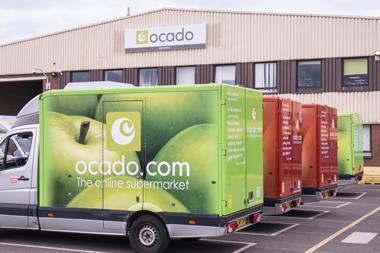Bring up Ocado’s website on your laptop right now and you’ll find in effect a barrier page apparently designed to repel all boarders.
The online grocer’s landing page is blank, other than a green strip displaying its logo and two choices – log in or register. There are no deals, enticing product pictures or marketing messages.
In short, there’s no sort of ‘come on’ for the registration option, presumably because Ocado is battling to step up to the demand challenges posed by the coronavirus outbreak and new customers are not the priority in the circumstances.
Ocado is not alone in confronting coronavirus disruption – the same is true in one way or another right across the grocery sector.
But what is surprising about Ocado is that, for all its tech prowess and the expectations of ‘agility’ that come with pureplay innovator status, it seems to have found it harder than others to adapt to these extraordinary times.
“The other grocers have one weapon in their armouries that Ocado does not – bricks-and-mortar shops”
We reported late last month that Ocado had to cope with demand 10 times higher than normal, a daunting challenge. But other grocers have faced a similar tsunami of shoppers.
The others have one weapon in their armouries that Ocado does not – bricks-and-mortar shops. And, during the pandemic, food stores and the supply chains that serve them have emerged as the stars.
Tesco highlighted that in its results earlier this month. The grocer reported: “Whilst we have already stepped up our capacity on grocery home shopping by more than 20%, and will continue to increase this, there is simply not enough capacity to supply the whole market. Between 85% and 90% of all food bought will require a visit to a store.”
That is partly so that vulnerable consumers can be prioritised for online delivery slots – Iceland has taken a similar stance – but it is a salutary reminder, too, that stores account for the bulk of food sales by a very long way.
There is no question that the health emergency will prompt further online retail take-up, but in the light of experience during the crisis many shoppers will remember that they were able to make essential purchases in shops. They might have had to queue, but not until the middle of next week or longer, as is often the case online.
Ocado’s present challenges in no way represent fundamental problems with its model or consumer appeal. But they rub off some of the etailer’s magic and stardust, and will make some think twice about whether it is worth registering as a customer.
Broker Jefferies said in a note earlier this month, analysing recent Trustpilot data, that “Ocado’s performance looks poor, albeit at a time of consumer frustration with the channel as a whole”.
Such issues matter more for Ocado because it is about to embark, in just five months’ time, on a new business phase through its joint venture with Marks & Spencer.
“Up until now, the benefits of the deal have been seen as primarily one-way and potentially ‘transformative’ for M&S – hence the high price-tag for M&S”
The core rationale of the deal still stacks up. The partnership will at long last allow M&S to sell its food online, and will enable M&S customers to do a full shop in one place, combining the retailer’s highly regarded own-brand products with those of Ocado and big consumer names such as Heinz.
Up until now, because of M&S’s absence from the online grocery arena, the benefits of the deal have been seen as primarily one-way and potentially ‘transformative’ for M&S – hence the high price-tag for M&S.
But, maybe in the longer term, benefits to Ocado could also prove highly significant.
As one correspondent put it to me this week, only slightly mischievously: “The M&S/Ocado deal was always positioned as a function of M&S’s urgent need to get access to the online channel for food delivery.
“I wonder whether Covid-19 has actually shown it’s just as strategically important for Ocado to get access to M&S’s click-and-collect capability through its stores?”


























No comments yet